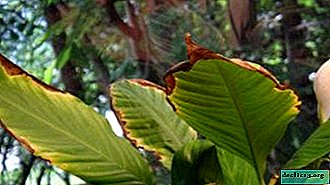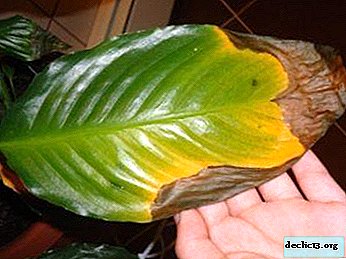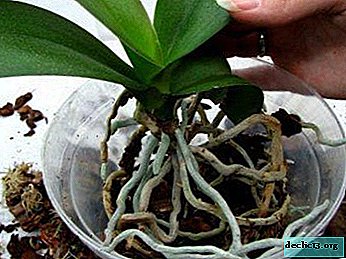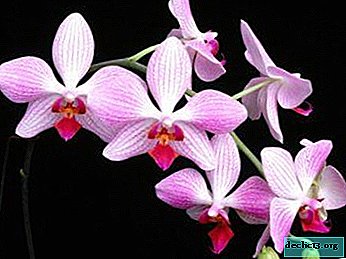Brown spots on leaves of spathiphyllum: why did they appear and how to cure a flower?

Spathiphyllum is also called "feminine happiness." According to legend, the goddess of love Astarte, getting married, gave this beautiful flower a force that brings happiness to every woman and girl who believes in him.
In this article, it will be described in detail what kind of plant it is and how it looks in a healthy state, as well as, in fact, why dark spots appear brown and black on the flower and what to do about it?
What kind of flower is this?
Spathiphyllum - a perennial growing in the wild in Central and South America, as well as on some islands of Southeast Asia. This flower grows at home, delighting with its unusual shape of flowers and large, glossy, bright green leaves.
What does he look like?
This is a small bisexual plant from 30 cm to 1 m tall, with a short rhizome and no stem at all - oval or with pointed tips leaves grow directly from the root. A peduncle comes out of the soil, ending with a flower similar to a corncob with a peculiar "veil" of greenish-white color and an oval shape with a pointed end.
Causes of Dark Spotting
Sometimes dark spots appear on the spathiphyllum. The causes of diseases of the leaves of spathiphyllum can be different:
 dry air in the apartment;
dry air in the apartment;- excessive watering or too rare watering;
- heterogeneity of the soil;
- hypothermia of the roots;
- sunburn;
- too much fertilizer;
- lack of trace elements, in particular iron;
- defeat by bacteria or fungi.
What does she face?
Such spots worsen the appearance of spathiphyllum and affect its general health, therefore they are a signal that the plant is improperly taken care of or it is affected by diseases, it can:
- disrupt the growth of a flower;
- to stitch flowering;
- lead to complete destruction.
Treatment
Depending on the type and location of the spots, treatment and resuscitation of spathiphyllum may be different.
Drying tips small in area
The reason for this leaf damage is too dry air in the apartment.
Measures to eliminate excessive flower aridity:
- spray at least twice a day;
- put the pot with the plant in a tray with wet expanded clay;
- put spathiphyllum next to any water tank.
Extensive tip lesions
At the same time, a small yellow border is visible between the healthy and affected part of the leaf. The reason for the large black spots is overflow.
Measures to eliminate the defeat of the tips of Spathiphyllum:
 observe a uniform watering regime: carry it out when the soil in the pot has dried up one third of its height;
observe a uniform watering regime: carry it out when the soil in the pot has dried up one third of its height;- not to allow complete drying of the soil and further too abundant watering.
As a rule, in most cases, just abuse of watering the soil is the cause of this disease. That is, the owners often completely forget to water the plant, and when the soil is completely dry, they begin to flood it abundantly and intensely with water.
The edges and the middle of the sheet plate turn black and dry
At the same time, there is also a narrow yellow border around the black area. The reason is the development of root rot as a result of too much prolonged watering.
Measures to eliminate the blackening and yellowing of the middle of the leaf plate of the plant:
- Take the plant out of the tank, rinse the roots until completely released from the ground (not under running water!).
- Cut the rotten parts of the roots with a knife, sprinkle the slices with activated carbon, and dry.
- Completely replace the earth in the pot, adding activated charcoal, transplant spathiphyllum without watering.
- Two days later, after the soil has dried, water the flower with settled, slightly warm water. Add Kornevin to the water.
Dark spots with a yellow border in the middle
The reason is the hypothermia of the roots if they were poured with cold water in the evening, and at night the temperature in the apartment dropped or the pot with the plant was in a draft.
Measures to eliminate black spots in a flower:
- put the flower in a warm place;
- water only with warm water;
- sprinkle with Epin (a stressful drug).
Extensive defeat without border
The reason is too much fertilizer applied. Typically, such spots appear very quickly after adding fertilizer: fertilized in the evening - in the morning the flower became ill.
Measures to eliminate excessive fertilizer in the soil of Spathiphyllum:
- Rinse the roots in clean water (not under running water!).
- Change the ground completely in the pot.
Yellowness
- Chlorosis may be the first cause of yellowing of the leaves of the spathiphyllum (a disease caused by a lack of iron in the soil). At the same time, the veins remain green, and the leaves themselves turn yellow and may fall.
To prevent chlorosis in a plant, you need:
 change the soil to lighter, as too dense retains moisture, which increases the alkaline component in it;
change the soil to lighter, as too dense retains moisture, which increases the alkaline component in it;- water the plant with the addition of several grains of citric acid per 1 liter of water - this will increase the acidity of the soil.
For the treatment of chlorosis should:
- spray the leaves with iron preparations (Ferovit, Antichlorosis);
- water the flower with the same preparations under the root for three days.
- The second possible reason is a sunburn from direct sunlight. Leaves become very thin and brittle; large yellow spots or stripes appear on them.
Measures to eliminate chlorosis in a flower:
- rearrange the flower in partial shade - on a window facing the north side;
- if in the house all the windows face the sunny side, then you can simply move the spathiphyllum from the window.
We explained in this material about the causes of yellowing in spathiphyllum not only of leaves, but also of flowers, as well as what to do in this case.
Foliage blackens from the edges, wrinkles and fades
The cause of the withering of the leaves of the spathiphyllum is gommosis (this disease is caused by the bacteria Xanthomonas dieffenbachiae, which enter the plant with drops of water). In addition, if Dieffenbachia, Anthuriums or Calla lilies grow near the flower, the risk of infection with hommosis increases.
Measures to eliminate gammosis:
- diseased leaves are torn off and thrown away;
- healthy leaves are washed with running water and laundry soap;
- treat the leaves and the whole flower with microbiological preparations Glyokladin, Alirin or Gamair;
- spray the flower over the leaves with a stressogen (Epin, HB-101).
About what to do if not only foliage withers, but also flowers of spathiphyllum, read here.
Prevention of Recurrent Diseases
In order for spathiphyllum not to be sick and to please with a healthy look of leaves, it is necessary to observe agricultural technology:
 water the plant on time and evenly: do not let it dry and do not pour;
water the plant on time and evenly: do not let it dry and do not pour;- provide loose soil and drainage, as well as optimal soil acidity (pH 5-5.5);
- put a pot of spathiphyllum under diffused sunlight;
- if necessary, feed with iron preparations;
- Do not plant Dieffenbachia, Anthuriums or Callas nearby.
Further care
After eliminating all the causes of spots on the leaves of spathiphyllum, it is important:
- maintain optimal temperature and humidity;
- spray the leaves on time;
- feed with mineral fertilizers for aroid plants that do not contain lime (for example, Biomaster, Flower) in a proportion of 1 g per 1 liter of water once a week.
Conclusion and conclusion
Spathiphyllum is a beautiful and original homemade flower with a moody character. So that he does not hurt and blooms for a long time, it is important to properly care for him and not make the care mistakes described in the article.

 dry air in the apartment;
dry air in the apartment; observe a uniform watering regime: carry it out when the soil in the pot has dried up one third of its height;
observe a uniform watering regime: carry it out when the soil in the pot has dried up one third of its height; change the soil to lighter, as too dense retains moisture, which increases the alkaline component in it;
change the soil to lighter, as too dense retains moisture, which increases the alkaline component in it; water the plant on time and evenly: do not let it dry and do not pour;
water the plant on time and evenly: do not let it dry and do not pour;















